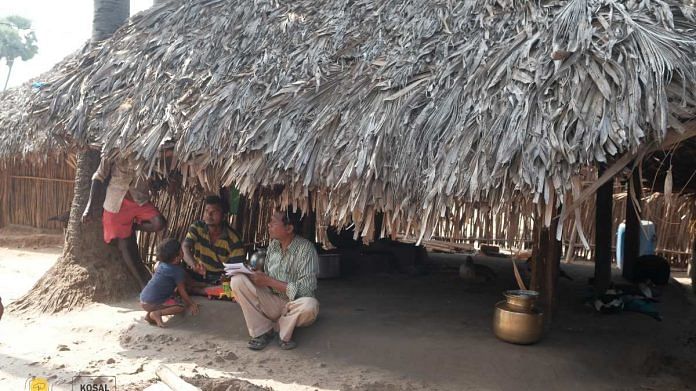Raipur: “In 2001, they thrashed and left me unconscious. When I came to my senses, there was nothing left in my demolished house. In 2004-05, I escaped the second attack and came to Bijapur city. Maoists thrashed me so badly that it hurts even today,” said Belaram, a native of Gomara village in Bastar.
Bhime, wife of Kodatam, another Naxal attack victim, said, “When Naxals came to know that my husband is a cop, around 60-70 armed people picked him up from our house at 9 pm and took him inside the forests where he was brutally murdered. After that horrific incident, we left our village and started living in Dantewada city.”
Ashok Minj of Vijayanagar fled home after Maoists killed his father for supporting the government’s anti-Naxal Salwa Judum initiative in 2004.
Like Belaram, Bhime and Minj, who migrated from Bastar in the last 20 years, about 1 lakh victims of Naxal violence are living in neighbouring states and other parts of Chhattisgarh as internally displaced persons (IDPs).
Their stories have been documented as part of a voluntary group’s project to prepare a ‘Victims Register’, a first-of-its-kind initiative in Chhattisgarh.
The group has started a drive to identify these victims and create a digital database, incorporating their accounts so a concrete rehabilitation plan can be chalked out for them.
The volunteers who are working on ‘Victims Register’ have formed an NGO, ‘New Peace Process’. They said they have so far identified about 5,000 IDPs within the state and their documentation is in progress.
According to them, in the last 20 years, approximately 65,000 people have migrated from Bastar to Telangana and Andhra Pradesh.
About 30,000-35,000 IDPs are residing in 14-17 clusters within the state, said the volunteers.
They include nearly 10,000 IDPs who migrated during the Salwa Judum initiative, said senior police officers in Bastar.
The state government has appreciated the move, but has raised questions about the credibility of the database.
Also read: In charts: Chhattisgarh is the most dangerous state for security forces fighting Naxalism
‘179 such IDP clusters identified so far’
New Peace Process convener Shubhranshu Chaudhary told ThePrint, “Victims Register will have the first person account of the Maoist victims who left their homes for fear of both Maoists and security forces. So far, 179 such IDP clusters have been identified. All of these are located in Telangana and Andhra Pradesh.”
Choudhary is an activist, writer and a former journalist with the BBC, who has covered the Northeast, and reported on the insurgency there.
He added: “According to an estimate, the number of IDPs displaced from Bastar and residing in both these states is around 65,000. Right now, information about 5,000 IDPs living in the state is being recorded in the ‘Victims Register’. Several young volunteers from universities and other institutions are personally recording the stories being narrated by these victims and then they are entering it into the register.”
According to Chaudhary, Victims Register has proved to be a “powerful tool or medium” to provide justice to IDPs internationally.
“In Colombia, Nepal and Philippines, the menace of the drug mafia and Maoists was brought under control using this. In Colombia, millions of IDPs were provided justice by enacting a Victim’s Law in 2011 with the help of a Victims Register created by social activists.”
He added: “In our case too, this process cannot be taken to its meaningful culmination, without the government support. We have sent a proposal of assistance from the state government, but are yet to get a response from them. There will be a reminder soon.”
“The government has no authentic data of the victims displaced due to Maoism. The digital register being compiled by us can prove to be very effective in this direction,” he added.
Also read: Dreaded Naxal Hidma is the new Maoist militia leader in Chhattisgarh
Govt sceptical
Meanwhile, officials at the state home department lauded the initiative, but they also raised concerns over the authenticity of the data.
Acting Chief Secretary Subrata Sahu said, “There might be some good intentions behind creation of the Victims Register, but how can the government verify the credibility of the data recorded in it?”
He added: “If the government considers this data to be correct then tomorrow many more self-help groups can come forward with their own set of records. However, the government is also not completely opposed to this exercise because this will definitely bring forward some sort of figures.”
Sahu said the government has the figure for only those people who informed the local government officials before leaving.
“The rehabilitation policy for Naxal victims is similar to that of labour migrants who resettle after coming back to the state,” Sahu added.
2009 survey of IDPs by Andhra govt
The Chhattisgarh government may not be keeping a tab on the migrants from Bastar, but in 2009, the Andhra Pradesh government and some non-governmental organisations had conducted a joint survey to find IDPs who migrated from Bastar to the state.
As many as 203 settlements of such IDPs were identified.
Social worker Venkatesh Jatwati, who was part of the survey, said, “The survey was held on the directions of the National Commission for Protection of Child Rights. These settlements with a population of 16,000 were identified on the banks of the Godavari river in Khammam district, which today also fall in East and West Godavari districts of Andhra Pradesh. There are several other IDP clusters here, but no survey was done.”
Also read: Get 500 Naxals of 1,600 in Dantewada to surrender — Chhattisgarh’s new rehabilitation plan



